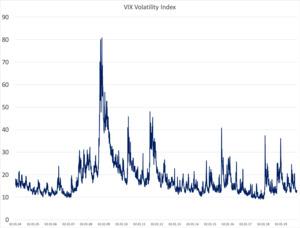CBOE Volatility Index
The CBOE Volatility Index (VIX) expresses the expected volatility of the US -amerikanischen stock index S & P 500 from. The VIX is the futures exchange Chicago Board Options Exchange calculates (CBOE) in real time and published.
concept
The volatility index VIX indicates the short-term fluctuation intensity expected by the market ( implied volatility ) based on option prices on the S&P 500 over 30 days in percentage points. A high value indicates a restless market, low values indicate a development without strong price fluctuations. The VIX is therefore also known as the “fear barometer”. It does not provide any information about the direction of the change, i.e. rising or falling prices. There is an opposite correlation between the VIX and the S&P 500 . When the S&P 500 falls, the VIX usually rises. If the S&P 500 rises, the VIX usually falls.
history
Historical overview
The VIX was in 1993 by the futures exchange Chicago Board Options Exchange calculates (CBOE) for the first time. In the first ten years, the calculation of the VIX was based on the S&P 100 , only when the calculation method was changed to the S&P 500 in 2003. Since then, the options actually existing at the CBOE have been included. This means that the calculation is no longer based on fictitious options. Since September 22, 2003 the CBOE has published two indices:
- CBOE Volatility Index (VIX)
- CBOE S&P 100 Volatility Index (VXO)
The VIX was back-calculated until 1990 (using the new method) and for the VXO until 1986 (using the old method).
The VIX reached a mathematical high on Black Monday , October 19, 1987, with a closing level of 150.19 points. That meant an increase of 113.82 percent compared to October 16, 1987. This Friday the index ended trading at 36.37 points. On Tuesday, October 20, 1987, the VIX marked a record high of 172.79 points in trading. However, this information was still determined using the old calculation method and relates to the S&P 100. The Chicago Board Options Exchange 2003 assigned this data to the CBOE S&P 100 Volatility Index (VXO).
On December 23, 1993, an all-time low of 8.86 points was achieved during trading and 9.04 points at the end of the day. In the course of the financial crisis , which began as the US real estate crisis in the summer of 2007, the index rose to its highest level since 1987. On October 24, 2008, it reached 89.53 points during trading. The CBOE Volatility Index achieved its highest daily closing value since 1987 on November 20, 2008 with 80.86 points.
Annual development
The table shows the annual high, low and closing levels of the CBOE Volatility Index (VIX) calculated back to 1986.
| year | Peak | Lowest point | Final stand |
|---|---|---|---|
| 1986 | 28.41 | 15.75 | 18.71 |
| 1987 | 172.79 | 10.43 | 39.45 |
| 1988 | 52.60 | 15.22 | 18.53 |
| 1989 | 51.71 | 11.60 | 17.39 |
| 1990 | 40.01 | 15.51 | 23.55 |
| 1991 | 38.21 | 12.16 | 20.17 |
| 1992 | 27.28 | 11.89 | 13.55 |
| 1993 | 18.00 | 8.86 | 11.46 |
| 1994 | 25.31 | 9.25 | 13.44 |
| 1995 | 18.27 | 10.41 | 13.89 |
| 1996 | 28.45 | 12.66 | 21.67 |
| 1997 | 55.48 | 13.24 | 24.89 |
| 1998 | 60.63 | 16.73 | 25.41 |
| 1999 | 36.79 | 17.70 | 26.71 |
| 2000 | 41.53 | 18.06 | 30.23 |
| 2001 | 57.31 | 20.26 | 23.22 |
| 2002 | 56.74 | 18.87 | 32.03 |
| 2003 | 41.16 | 14.83 | 18.31 |
| 2004 | 22.67 | 11.14 | 13.29 |
| 2005 | 18.59 | 9.88 | 12.07 |
| 2006 | 23.81 | 8.60 | 11.56 |
| 2007 | 37.50 | 9.70 | 22.50 |
| 2008 | 89.53 | 15.82 | 38.81 |
| 2009 | 57.36 | 19.25 | 21.68 |
| 2010 | 48.20 | 15.23 | 17.75 |
| 2011 | 48.00 | 14.27 | 23.40 |
| 2012 | 27.73 | 13.30 | 18.02 |
| 2013 | 21.91 | 11.05 | 13.72 |
| 2014 | 31.06 | 10.28 | 19.20 |
| 2015 | 53.29 | 10.88 | 18.21 |
| 2016 | 32.09 | 10.93 | 14.04 |
| 2017 | 17.28 | 8.56 | 11.04 |
| 2018 | 50.30 | 8.92 | 25.42 |
| 2019 | 28.53 | 11.03 | 13.78 |
See also
Web links
Individual evidence
- ↑ Chicago Board Options Exchange: CBOE Volatility Index (VIX)
- ↑ Chicago Board Options Exchange: Historical data from 1986
- ↑ Yahoo: Historical data from 1990
- ↑ Federal Reserve Bank of St. Louis: Historical data from 2004
- ↑ a b c d e f g VIX data for 2004 to present (Updated Daily). (csv; 147kb) In: VIX Index Historical Data. Cboe Options Exchange, November 24, 2019, accessed November 24, 2019 .
- ^ VIX data for 2004 to present (Updated Daily). (csv; 145kb) In: VIX Index Historical Data. Cboe Options Exchange, January 21, 2020, accessed January 21, 2020 .
